| Pages:
1
2
3
4 |
Hey Buddy
Hazard to Others
  
Posts: 384
Registered: 3-11-2020
Location: Bushwhacker Country
Member Is Offline
|
|
Quote: Originally posted by MineMan  | I wrote those things because I don’t want someone blowing up firings melt cast because of sulfuric acid in the crystals.
You do fit in. You may not have noticed but you actually revived this forum which was pretty much dead. You have done great investigative work.
We’re just impatient because it seems so damn promising.
The CHP works, every time. If you get the grain sizes even remotely close.
Standard tests are great. But we can also tell a lot from 1 melt cast gram in a tube placed on scrap steel. Or burying a 6mm copper tube in a 5 gallon
bucket of sand and collecting the fragments.
You have done insane work, but everyone here wants a 9kms melt cast…. So you must deliver. Then we can be business buddies  and hopefully find a way to use your invention. and hopefully find a way to use your invention.
Also, invite your wife into the garage with a little lab coat role play so she is more willing of your project  )) ))
PS. If I sound insane it’s just the genius in me
[Edited on 16-11-2022 by MineMan] |
I understand, I will try to get some testing done. Here's where I'm at as of tonight:
Prepared new CHP per LLs videos. Exact copy. In contact with LL to clarify ammonation. CHP is monochromatic crystals slightly damp, not sticking to
walls of glass vessels/spoons/pan. 6mm load testing in morning, similar to LL but I only have Ti right now, I assume that should be fine for CHP (in
terms of confinement properties of metal). If not, I can prepare some 6mm SS casings. Will calc in morning to determine press distance within that
cavity to match density quoted, (no pressure figure was given).
If CHP cap firing is a go, will move on direct to testing melt cast samples on steel and lead. If theres a no-go issue, will recircle and focus on a
quick primary to get firing. After initial comparison to ETN, can load PETN. Tonight finished fuming nitric, so will prepare the K-6/RDX quick mix.
Big bottle of PETN already made. Melt casted ETN earlier tonight. So it's all on the CHP (No pressure), then after that its all on this compound (no
pressure, well, hopefully >30GPa)
I dont know if it will "deliver" or not, but its a triazine that is deflagrating and melting, so it's going to be energetic and the fact that it melts
means it is useful regardless of its comparative performance. Even if it's det velocity were 7000 m/s it would still be useful because TNT is
difficult to prepare and ETN is too sensitive for large castings, without phlegmatizing or plasticizing or adding inerts. Other state of the art melt
casts are very niche and are not applicable to amateurs, like melt azoles or propyl-Nitroguanidine. But this melt cast is immediately reproduceable by
anyone with the basic materials. No triple stage nitration, nothing like that. Just throw in a big bottle and filter rinse, recrystallize and melt.
anyways, we will get to performance tests asap
|
|
|
Hey Buddy
Hazard to Others
  
Posts: 384
Registered: 3-11-2020
Location: Bushwhacker Country
Member Is Offline
|
|
I have steel meshed mixed the CHP into a small grain, does it need to be large grain like original TACP? Hopefully not.
|
|
|
MineMan
National Hazard
   
Posts: 996
Registered: 29-3-2015
Member Is Offline
Mood: No Mood
|
|
CHP is very forgiving… any metal confinement is fine.
Of course I have mentioned the best primary here before. Copper amino guanidine perchlorate. I am not encouraging or suggesting. Rather it’s
something you will probably read about so it exists is all I am saying.
|
|
|
Microtek
National Hazard
   
Posts: 827
Registered: 23-9-2002
Member Is Offline
Mood: No Mood
|
|
Personally, I prefer the nickel variant, but copper probably produces less toxic compounds on detonation. It's mainly a matter of taste.
Anyway, I have been doing some preliminary synthesis experiments with NTNT. I did it once via sulfuric and once via hydrochloric acid. During the
H2SO4 mediated synthesis (scaled down to 1/10 of the reactants) I noted that if the prescribed method is followed using pristine needle crystals of
NQ, large amounts of it are recovered on filtration. I extracted the filtered mass of crystals and amorphous powder several times with acetone,
neutralised the acetone soln with NaHCO3 and evaporated the solvent at room temp in an airstream. This produced 1,766 g of yellow flaky crystals
corresponding to 36% yield, assuming the product to be pure NTNT. I then tested the melting point in a glass capillary, and found an onset of melting
at 75 C, but the bulk of the material remained unmelted at 100 C. I haven't tested any detonics yet.
I then read the papers with the original experiments, and noted that the un-nitrosated triazine must be quite stable (the authors prepare it by
heating at 50-55 C for 3 hours). I then tried the HCl mediated procedure (as per the bit-chute video, and again scaled to 1/10), but did not add ice
or cool the reaction until I was about to add the NaNO2. I also used lab-grade HCl and magnetic stirring instead of intermittent swirling. The NQ was
still not very soluble in aqueous HCl, but when the hexamine was added it evidently reacted and the solution turned clear after about 5 minutes of
stirring. Then ice was added and the nitrite solution was added all at once. Some effervescence was observed, but only slight foaming. After 30
minutes a dense pricipitate had formed, similar to RDX in its tendency to settle. This was easily filtered (I had set up for Buchner filtration, but
that would not have been necessary), washed on the filter and air dried overnight to yield 1,17 g of crude product.
The mother liquor had been set outside to off-gas overnight, and significant amounts of additional precipitate had formed in the morning. I have not
had time to isolate it yet, so I don't know how much. 1,17 g would correspond to about 31% yield.
I don't quite understand why you would assume that ionic derivatives might be formed. I think NTNT must be a very weak base; even the un-nitrosated
parent molecule is a weak base and its HCl salt can be converted to free base by heating with 18% HCl. Even partially nitrosated derivatives must be
orders of magnitude weaker.
I find it much more likely that what you are seeing is either differing degrees of nitrosation or maybe presence of impurities such as sulfuric acid
(which can be notoriously difficult to remove), or maybe unreacted starting materials in differing amounts.
|
|
|
Hey Buddy
Hazard to Others
  
Posts: 384
Registered: 3-11-2020
Location: Bushwhacker Country
Member Is Offline
|
|
Quote: Originally posted by Microtek  |
Anyway, I have been doing some preliminary synthesis experiments with NTNT. I did it once via sulfuric and once via hydrochloric acid. During the
H2SO4 mediated synthesis (scaled down to 1/10 of the reactants) I noted that if the prescribed method is followed using pristine needle crystals of
NQ, large amounts of it are recovered on filtration. I extracted the filtered mass of crystals and amorphous powder several times with acetone,
neutralised the acetone soln with NaHCO3 and evaporated the solvent at room temp in an airstream. This produced 1,766 g of yellow flaky crystals
corresponding to 36% yield, assuming the product to be pure NTNT. I then tested the melting point in a glass capillary, and found an onset of melting
at 75 C, but the bulk of the material remained unmelted at 100 C. I haven't tested any detonics yet.
I then read the papers with the original experiments, and noted that the un-nitrosated triazine must be quite stable (the authors prepare it by
heating at 50-55 C for 3 hours). I then tried the HCl mediated procedure (as per the bit-chute video, and again scaled to 1/10), but did not add ice
or cool the reaction until I was about to add the NaNO2. I also used lab-grade HCl and magnetic stirring instead of intermittent swirling. The NQ was
still not very soluble in aqueous HCl, but when the hexamine was added it evidently reacted and the solution turned clear after about 5 minutes of
stirring. Then ice was added and the nitrite solution was added all at once. Some effervescence was observed, but only slight foaming. After 30
minutes a dense pricipitate had formed, similar to RDX in its tendency to settle. This was easily filtered (I had set up for Buchner filtration, but
that would not have been necessary), washed on the filter and air dried overnight to yield 1,17 g of crude product.
The mother liquor had been set outside to off-gas overnight, and significant amounts of additional precipitate had formed in the morning. I have not
had time to isolate it yet, so I don't know how much. 1,17 g would correspond to about 31% yield.
I don't quite understand why you would assume that ionic derivatives might be formed. I think NTNT must be a very weak base; even the un-nitrosated
parent molecule is a weak base and its HCl salt can be converted to free base by heating with 18% HCl. Even partially nitrosated derivatives must be
orders of magnitude weaker.
I find it much more likely that what you are seeing is either differing degrees of nitrosation or maybe presence of impurities such as sulfuric acid
(which can be notoriously difficult to remove), or maybe unreacted starting materials in differing amounts. |
Microtek, I really appreciate your further development of this compound. I agree with your assessment completely. Presence of needles is indicative of
unreacted NQ. For most experiments I used Metelkinas methods for small batch NHHT, and mod'd it with .072 mol (4.96 g) nitrite rounded up to excess @
5 g. With HCl there is a rubicon, either a foam precipitate or a fizz reaction. It is possible to precipitate "m1" (see photos) which is a white
powder free of the lemon color and more dense. "m1" appears to perhaps be NHHT (Im not sure yet, my NHHT control is evaporating today). This m1 was
achieved by using 12.5 ml HCl / 5 g NaNO2 / 2.5 g NQ / 2.6 g Hexamine. Added NQ+Hexamine to HCl @ 10.9 C, then wetted NaNO2 to dissolve it and dripped
in. Opaque foam is produced instantly then after ~2minutes turns clear. White material on filtering. Seems different color, different morphology,
powder not a foam or fiber, on open flame burning the white powder burns very fast and projects (blows apart and projects out) small pieces of white
material.
This and the slight differences in H2SO4 made me assume there was a possibility of ionic species but I wasnt sure, it could also be NHHT, the only
problem is where did the nitrite go? it's not in rxn vessel, material is white, perhaps its in solvent? I would yield to your better judgement, you
are obviously more experienced and knowledgeable in this sort of thing. If there shouldn't be ionic species there probably aren't.
On stability of NHHT, I agree it seems stable enough and seems like it could be a good candidate for thermal stimulated ddt, if it's true that it
explodes at 102 C, it should have a low critical diameter of <2 mm similar to other energetic triazines. The claim of 102 C explosive decomp was
found in was "Nitroguanidine Poly nitro compounds Zhuang" pdf, found in first page of thread.
[Edited on 16-11-2022 by Hey Buddy]
[Edited on 16-11-2022 by Hey Buddy]
|
|
|
Laboratory of Liptakov
International Hazard
    
Posts: 1334
Registered: 2-9-2014
Location: Technion Haifa
Member Is Offline
Mood: cool.gif
|
|
Microtek couldn't take it anymore and made his own synthesis......
By the grams I see a good yield...... .....The theory surrounding NTNT is
starting to become clearer. .....The theory surrounding NTNT is
starting to become clearer.
Basically works any size of CHP grain. 0.5 x 0.5 mm, 1x1, or 2x2. Bigger grain has generally more reliable DDT. With execpt output segment, which is
monolite as stone.
[Edited on 16-11-2022 by Laboratory of Liptakov]
Development of primarily - secondary substances CHP (2015) Lithex (2022) Brightelite (2023) Nitrocelite (2024)
|
|
|
Hey Buddy
Hazard to Others
  
Posts: 384
Registered: 3-11-2020
Location: Bushwhacker Country
Member Is Offline
|
|
Quote: Originally posted by MineMan  |
Copper amino guanidine perchlorate. I am not encouraging or suggesting. Rather it’s something you will probably read about so it exists is all I am
saying. |
I would very much like to learn more about this. Zinc is commonly used for reduction of NQ to pimagedine but it's very messy. The electrolytic
reduction works very cleanly on basic lead, I've found most people are unaware of this method.
Attachment: AMINOGUANIDINE ELECTROLYTIC.pdf (599kB)
This file has been downloaded 142 times
|
|
|
Hey Buddy
Hazard to Others
  
Posts: 384
Registered: 3-11-2020
Location: Bushwhacker Country
Member Is Offline
|
|
Don't want to drop a nail biter, but I had failures to prime on the CHP using TiH2/Mg/KCLO4/NC firstfire and either Pyrodex or Triple based rifle
powder as a prime.
I was able to initiate CHP on third cap attempt, but no-go on DDT, just deflagration. Earlier this week, I was able to detonate CHP with a hammer when
it was dry but I learned that is the incorrect state, to be detonating CHP dry. It should be slightly damp with NH4OH. I thought I was going to see no
issue in this regard.
I'm not saying the CHP failed, I'm sure it's my preparation that failed or some other factor, but I replicated the process as best as I could and had
no luck. I should mention I do tend to have a lot of misfires generally, and the only caps I prefer are high powered M14s which are azide and RDX, but
most importantly, not made by me. Everything else Ive tried besides high voltage EBW or azide, has not had good luck. So take the report of failure
lightly because I have not found a primary that works for me.
Im taking the rest of the day off. Hopefully I have time to cook the rdx/k-6 quick mix tonight and consider what to try next. Maybe just stage some
8mm loads so they are all ready when I find a new primary. I have found that using 8mm SS straws with a ~1mm wall are somewhat more easily bulged than
other SS tube stock. I may switch to all tube stock, but I was really hoping the straws would handle high pressure pressing as they are so plentiful
and cheap. They still work excellent for hand pressing. ETN seems to press very well as LL suggested, melting, then breaking up and pressing, same is
true of the NTNT.
If anyone is interested in this compound and you are set up to go and willing to accept the risk of experimental preparation of an unknown compound,
you are more than welcome, this is not "my thread" or "my compound", but most of all, I don't like being on the spot for failure, (HELP ME), I'm sorry
I couldn't deliver timely field tests today.
I noticed during preparation that the NTNT from H2SO4 (when crude and Un recrystallized) does not melt as easily as recrystallized HCl, it still melts
to a high density but some early preparations of NTNT that I made heat up easily and can be poured like runny mustard. See video example on page 1, I
was able to just slap it on a hot plate in a coors bowl and watch it melt, then roll it around in the bowl. Im pretty sure that was all NTNT from the
LLNL mod synth first posted. but I wasnt separating samples at first. Hopefully HCl and H2SO4 both melt well when recrystallized.
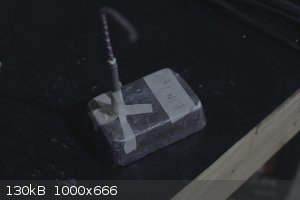
|
|
|
B(a)P
International Hazard
    
Posts: 1112
Registered: 29-9-2019
Member Is Online
Mood: Festive
|
|
Quote: Originally posted by Hey Buddy  | Quote: Originally posted by MineMan  |
Copper amino guanidine perchlorate. I am not encouraging or suggesting. Rather it’s something you will probably read about so it exists is all I am
saying. |
I would very much like to learn more about this. Zinc is commonly used for reduction of NQ to pimagedine but it's very messy. The electrolytic
reduction works very cleanly on basic lead, I've found most people are unaware of this method.
|
I have experimented with the nickel salt quite a bit, but Microtek would be a better source of knowledge than me on this. Check this thread out for
some more information including a patent with a procedure for a large number of salts including diaminoguanidine nickel diperchlorate.
https://www.sciencemadness.org/whisper/viewthread.php?tid=158381
Well done on your work to date and thanks very much for sharing.
I am definitely watching on with interest.
|
|
|
Laboratory of Liptakov
International Hazard
    
Posts: 1334
Registered: 2-9-2014
Location: Technion Haifa
Member Is Offline
Mood: cool.gif
|
|
CHP does not need any additional primary substance. It is a primary-secondary substance. The output segment is pressed to approximately 1:5 g/cc.
The rest of the resistive bridge cavity (around the bridge) is filled with low-density CHP. Estimated 0.8 - 1g/cc. The condition is, of course, a
steel (or copper) cavity with a 1mm wall. And central electric ignition. The fuse only lights from one end. But a centrally placed electric bridge to
all sides at once. It call hotline system, or Berta system.
Desing of bridge on page 2 of this thread. If you will use method with the fuse, it can failed often. By your picture it seems, that your cavity has
thin the wall. I estimate 0.3 - 0.5 mm of aluminium or SS. It is not enough for CHP. CHP is safe to handle but requires a 1mm wall.
Next: On picture are basic value for shooting to the Lead. Especially for ETN 300mg and 1000mg.
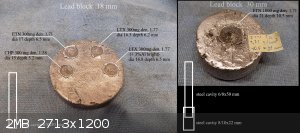
[Edited on 16-11-2022 by Laboratory of Liptakov]
Development of primarily - secondary substances CHP (2015) Lithex (2022) Brightelite (2023) Nitrocelite (2024)
|
|
|
MineMan
National Hazard
   
Posts: 996
Registered: 29-3-2015
Member Is Offline
Mood: No Mood
|
|
No explosive will ddt when wet
|
|
|
MineMan
National Hazard
   
Posts: 996
Registered: 29-3-2015
Member Is Offline
Mood: No Mood
|
|
Hey buddy. DM me and let’s talk on discord. Let’s get this nailed down. I see easy mistakes
|
|
|
Laboratory of Liptakov
International Hazard
    
Posts: 1334
Registered: 2-9-2014
Location: Technion Haifa
Member Is Offline
Mood: cool.gif
|
|
Hey Buddy, I tried a 0.4 mm weak wall brass cavity just to be sure. The CHP operates at full capacity in this cavity. Drying was 15 minutes at 50 C.
So if your CHP is not working, the problem is not a weak cavity or too dry CHP. Everything else in the picture.
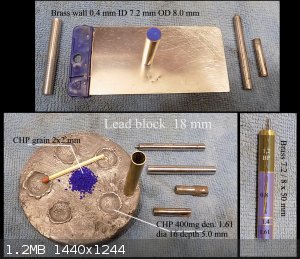
Development of primarily - secondary substances CHP (2015) Lithex (2022) Brightelite (2023) Nitrocelite (2024)
|
|
|
Hey Buddy
Hazard to Others
  
Posts: 384
Registered: 3-11-2020
Location: Bushwhacker Country
Member Is Offline
|
|
Quote: Originally posted by Laboratory of Liptakov  | Hey Buddy, I tried a 0.4 mm weak wall brass cavity just to be sure. The CHP operates at full capacity in this cavity. Drying was 15 minutes at 50 C.
So if your CHP is not working, the problem is not a weak cavity or too dry CHP. Everything else in the picture.
|
Thank you LL. The cavity was a Ti 1mm nominal wall, it measured in actual .8mm. I liked to try the CHP, and its simplicity for preparation as a quick
solution is attractive to me for situations like this, but it is too difficult a preparation for me in overview of what is necessary in the process,
and I have had trouble with understanding it's behavior dry/wet. I prefer azides, but I dont think azides are ideal and I think it means its time to
find a new primary. I am going to probably try nitriminotetrazole, aminonitroguan or aminoguan salt. Guanidium and triazines are the main focus of my
interest so if I can locate a good-performance primary from that family tree, it would be the best choice for simplicity and the use of reagent stock.
The NTNT preparation is very fast and a few grams can be made and dried in a couple of hours if the NQ is already prepared. I have dried it up to 80c,
that maybe too high. Microtek claims a capillary mp of ~75, so maybe 60 C is a more-appropriate drying temp. Point being, a person with a primary
already made and ready to fire can make NTNT faster than I can make CHP.
--Other note: I believe the NHHT is dry now and I will test that and compare it to M1 to see if they are the same. If it can be detonated at 102C,
perhaps I can use it to detonate NTNT samples. Perhaps...
|
|
|
Laboratory of Liptakov
International Hazard
    
Posts: 1334
Registered: 2-9-2014
Location: Technion Haifa
Member Is Offline
Mood: cool.gif
|
|
Thanks for reply, Buddy......If I ever make NTNT I will force him to DDT.....
Development of primarily - secondary substances CHP (2015) Lithex (2022) Brightelite (2023) Nitrocelite (2024)
|
|
|
Hey Buddy
Hazard to Others
  
Posts: 384
Registered: 3-11-2020
Location: Bushwhacker Country
Member Is Offline
|
|
Update on this general effort: Ive tried the NHHT HCl preparation twice now and I can't get it. Directly attempting hexahydro triazine
monohydrochloride leaves me with a ~1.7 -2 g yield of a white powder that is not flammable and doesnt hammer det. Presumably the 18% HCl free base
version would be easier to yield something but it wouldnt be the HCl that purportedly explodes at 102 C, which is what any concern was around the
issue in the first place.
I would say that the possibility of producing either variant of NHHT during an attempted NTNT synthesis is low and when excess nitrite is used and the
reaction is given plenty of time, the probability is even lower. It is still not established that NHHT HCl detonates at 102 C and literature is a bit
conflicting on this.
Beyond that there is definitely a second material, (pictures earlier in thread) labelled "M1" that has different burning and melt characteristics than
NTNT. This "M1" was found by beginning the HCl version of NTNT synthesis, but using no ice cooling, or additional water and only using a few ml of
water to dissolve and add NaNO2. It begins forming as a white foam and then the foam contracts into an opaque liquid that then becomes clear and
fizzes. While that is happening there is a bit of red gas evolved. The material is white and burns much faster than NTNT. This "M1" material doesnt
melt at 110 C like NTNT. It doesn't transition to detonation confined in Al foil. I dont know what it is, because of lack of dilution, it seems
unlikely to be NHHT free base, but it's beyond my ability to identify. There is a chance it could be a nitrimino version of DNPT which is the acetic
acid derived version of TMTN R Salt, but in this case it would have the nitrimino that would make it whiter in color, but this is just a wild
speculation. Regardless, It seems unlikely that a person would inadvertently synthesize this m1 material accidentally because the lack of cooling and
dilution leads to loss of NTNT, and so the entire course of using deficient water and ice seems like it would be naturally avoided. If it were
produced it doesnt decompose nor explode at the working mp of NTNT, so it seems there is no danger there for a potential accident in the production of
NTNT.
I haven't tested with partially deficient nitrite yet (which is another possibility) but I think as long as three moles of nitrite are used per mole
of hexamine (at minimum. excess is better though), there's not much danger there.
---
I think the only risk learned with NTNT at this point is if you drink it, or its dramatic decomposition to H2SO4 which is something already seen in
other nitrososamines, Hydrazine Nitrates etc. and so is no unexpected surprise. I diverted from metal compatibility testing because of worry about
these issues but now I will refocus on that, melt castability and compatibility with common metals and charcoal. To avoid H2SO4 decomposition issues,
I recommend using the slightly lower yielding HCl derived version. The ratio of NQ could be lessened as there seems to always be excess unconverted NQ
in the HCl method. To simplify testing, I'm going to be only the HCl derived NTNT using that for future study unless a good reason comes up to change
it or try a different method.
Other developmental interests with NTNT that are way out of scope for now but possible future investigation includes mild oxidation of NTNT to an even
more oxygen rich version. That could be a nitrimino/nitro/dintitroso variant or something unexpected. Avoidance of HNO3 is critical to keep the
reagents as simple as possible. I seem to have had partial success oxidizing TMTN and a "keto" TMTN using AcOH/NH4NO3 in the past. Electro oxidation
in a 30% ammonium sulfate solution seems like a promising unexplored possibility for these nitroso compounds. I have had success in reduction of
nitroguanidine with the same method in high yield. I have not had success with perborate or percarbonate AcOH oxidation nor H2O2. Peroxynitrite might
be another OTC possibility that seems mostly unexplored in energetic materials but if Im not mistaken all the right radicals are there and I believe
peroxy nitrite goes through phases in reation and may even become HNO3 in later stages of some reactions but is a nitrite salt plus a percarbonate or
perborate or peroxide, (at least I think, I have only made peroxynitrite once, i think once I may have even used grocery store citric acid, cant
remember). Digression. Anyways, IMO there are a range of possible routes to higher oxidation of nitrosamines in general to get them into nitro ball
park that are unexplored but could be very useful.
In the case of NTNT, the highest appeal is melt castability which is most likely dependent on its being a nitrosamine, so it's likely already in its
most useful form and might suffer loss of that characteristic if it were altered.
[Edited on 19-11-2022 by Hey Buddy]
[Edited on 19-11-2022 by Hey Buddy]
|
|
|
Laboratory of Liptakov
International Hazard
    
Posts: 1334
Registered: 2-9-2014
Location: Technion Haifa
Member Is Offline
Mood: cool.gif
|
|
It seems that preparing dangerous NHHT makes considerable difficulties. This is good news. You still seem to have 10 fingers and other organs intact.
After a lot attempts. The NTNT preparation appears to be sufficiently safe. When following the procedure with HCl. (Is time to tear up some iron)
Development of primarily - secondary substances CHP (2015) Lithex (2022) Brightelite (2023) Nitrocelite (2024)
|
|
|
Microtek
National Hazard
   
Posts: 827
Registered: 23-9-2002
Member Is Offline
Mood: No Mood
|
|
A small update: I redissolved the material that I had extracted with acetone from the sulfuric acid mediated process (again using acetone), and then
added the clear solution to water. There was no immediate precipitate, but over the next 12 hours a yellow, crystalline product appeared. I tested the
melting point of this material in a standard glass capillary. At a heating rate of ca. 5 degrees (C) per minute, the product melted cleanly at 75 C,
and upon further heating decomposed at 125-140 C.
The material reacts as a typical secondary when exposed to flame, but I was unable to initiate it by hammerblow.
I also tested the material I had prepared by the slightly modified HCl mediated method (the one that didn't foam, and didn't produce red fumes). This
product which in appearance is a very pale yellow amorphous powder, is only slightly soluble in acetone. I haven'tmeasured it exactly, but I would
estimate around 1g per liter of acetone. This material deomposes without melting at 175-180 C, but reacts to flame in much the same way as the other
material. I wasn't able to hammer-initiate this one either.
I don't know if either of these materials are the same as what Hey Buddy has produced, but they are definitely two different chemicals. I will try to
get a basic plate dent test done soon. If this gives promising results, I will measure VOD.
[Edited on 24-11-2022 by Microtek]
|
|
|
Laboratory of Liptakov
International Hazard
    
Posts: 1334
Registered: 2-9-2014
Location: Technion Haifa
Member Is Offline
Mood: cool.gif
|
|
If it didn't go with a hammer blow, it should go with an even bigger hammer blow. The reason I haven't tried NTNT yet is because I haven't seen a
single explosion of this substance. Respectively any hole from this.
Thanks, Microtek for your examination about NTNT. Your paralel research is same important as from Buddy. We appreciate it, even if the whole effort
maybe will for naught.
[Edited on 24-11-2022 by Laboratory of Liptakov]
Development of primarily - secondary substances CHP (2015) Lithex (2022) Brightelite (2023) Nitrocelite (2024)
|
|
|
Hey Buddy
Hazard to Others
  
Posts: 384
Registered: 3-11-2020
Location: Bushwhacker Country
Member Is Offline
|
|
Quote: Originally posted by Microtek  | A small update: I redissolved the material that I had extracted with acetone from the sulfuric acid mediated process (again using acetone), and then
added the clear solution to water. There was no immediate precipitate, but over the next 12 hours a yellow, crystalline product appeared. I tested the
melting point of this material in a standard glass capillary. At a heating rate of ca. 5 degrees (C) per minute, the product melted cleanly at 75 C,
and upon further heating decomposed at 125-140 C.
The material reacts as a typical secondary when exposed to flame, but I was unable to initiate it by hammerblow.
[Edited on 24-11-2022 by Microtek] |
This makes corroborative sense. I found a seeming mp on attempting crude melt on Thiele tube with propylene glycol media at 95 C (not entirely
accurate). And an observed crude working mp at ~110 C with an observable reversion to solid phase at 68 C. A 75 C mp lines up perfectly with naked eye
observation of solid phase reversion at 68 C.
This is very exciting. 75 C is a very good mp for a practical energetic material. About as ideal as can be, lower mp can become problematic in some
practical situations and 75 C is low enough under boiling water temp to permit that method for melting.
I suspect the seeming inconsistencies Ive seen in getting a good melt cast off of NTNT are due to the low density state of non recrystallized
material. In the unrecrystallized state, NTNT appears to loosely hold itself up out of the melt making melting more challenging where as when using
dense crystal for melt cast, it falls into its own melt and melts completely. It is certainly thin enough to pour.
In my testing I was only able to initiate detonation by hammer blow by striking on a 50lb vise with a 16 oz flat face hammer. The force needed was
enough to tilt over the vise when sitting on the ground. It was a pretty hard strike. Much harder than comparable force needed for ETN or PETN. In
fact it was so hard that in my initial notes from early testing of the material, I wrote "no hammer det" assuming that it was not that energetic, it
is simply somewhat insensitive compared to other stuff like K-6 or PETN. Assuming performance is there, this also lends quite favorably to NTNT
profile.
Microtek, no pressure, but if you get the opportunity to measure density on some casted NTNT, it would be helpful confirmation measurement. I recorded
density of 1.83 g/cc but there were visible air bubbles solidified in my sample.
Currently drying out some trays pf NQ for NTNT and building an electroreduction apparatus to prepare aminoguanidine (metal) perchlorates in quest for
next in-house primary. NTNT metal compatibility testing soon. Will hopefully get to performance testing sometime probably after microtek arrives at
his conclusions.
Things looking good. Performance tests are the only hold up at this juncture.
Microtek I'd like to more know about your method of acetone extraction that you briefly mentioned. I have only used acetone for recrystallization and
so I'm curious what you found on extraction technique.
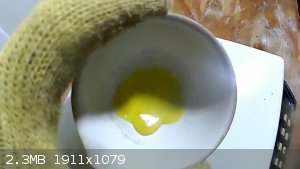
|
|
|
Microtek
National Hazard
   
Posts: 827
Registered: 23-9-2002
Member Is Offline
Mood: No Mood
|
|
The extraction I did was just adding acetone to the mix of crude product and unreacted nitroguanidine, then decanting the liquid phase (NQ is almost
insoluble in acetone). I extracted three times (about 7 ml acetone on extraction 2 and 3. Number one required a little more to properly wet the
crystal mass), at which point the yellow colouring of the solid phase was almost gone. The collected extracts were then poured into a dish and
evaporated to dryness in the airstream from an aquarium pump.
I then later (after measuring the mp) redissolved the recovered crystals in more acetone and poured the solution into water to recover the material
melting at 75C.
I agree that the mp is close to ideal for a meltcast energetic, though I would have liked the decomposition temperature to be a little higher, maybe
180C. If I can see gas evolution at 125-140C, there is a high likelyhood that the decomposition onset is lower than that. Of course, it remains to be
seen if the product I have made is even NTNT at all. I speculate that the difference in product characteristics may be due to one or more of them
being a linear nitrosamine rather than a cyclic one, a less nitrosated variant or maybe a combination of the two.
|
|
|
KNEWKID
Harmless

Posts: 5
Registered: 24-11-2022
Member Is Offline
|
|
There are at least 2 groups of compounds here in this mixture. I extracted yellow to orange crystals using NM and white powder was left over. Pics
later
|
|
|
KNEWKID
Harmless

Posts: 5
Registered: 24-11-2022
Member Is Offline
|
|
Extraction NTNT with Nitromethane
Orange crystal fraction soluble in pure nitromethane white powder insoluble in NM. Large mass of NTNT crude about 1/2 to 3/4 lb when dry.
Note: first extraction in NM cool yielded yellow crystals. 2nd extraction heated to 100F NM product turned orange...possible secondary rxn.
Will upload Raman spectra of each material later
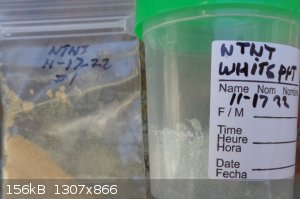
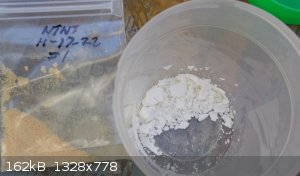
|
|
|
KNEWKID
Harmless

Posts: 5
Registered: 24-11-2022
Member Is Offline
|
|
NTNT bulk 1/2 to 3/4 lb when dry
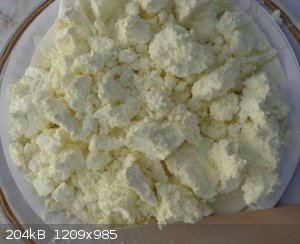
|
|
|
KNEWKID
Harmless

Posts: 5
Registered: 24-11-2022
Member Is Offline
|
|
NTNT soaking in pure NM
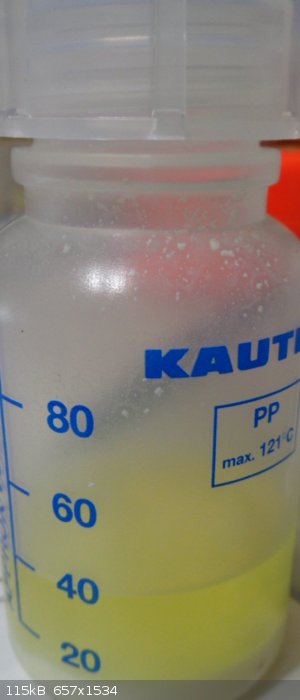
|
|
|
| Pages:
1
2
3
4 |